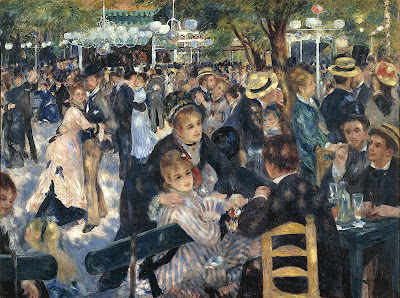Wednesday, September 8, 2010

A core group of young realists, Claude Monet, Pierre-Augusta Renoir, Alfred Sisley, and Frederic Bazille, who had studied under Charles Gleyre, became friends and often painted together.
They soon were joined by Camille Pissarro, Paul Cézanne, and Armand Guillaumin.
In an atmosphere of change as Emperor Napoleon III rebuilt Paris and waged war, the Academic des Beaux-Arts dominated the French art scene in the middle of the 19th century.
The Academic was the upholder of traditional standards for French painting, both in content and style.
Historical subjects, religious themes, and portraits were valued ,and the Academic preferred carefully finished images which mirrored reality when examined closely.
Color was sober and conservative, and the traces of brush strokes were suppressed, concealing the artist's personality, emotions, and working techniques.
The Academic held an annual, juried art show, the Salon de Paris, and artists whose work displayed in the show won prizes, garnered commissions, and enhanced their prestige.
The standards of the juries reflected the values of the Academic, represented by the highly polished works of such artists as Jean-Leon Gerome and Alexander Cabanel.
They were more interested in painting landscape and contemporary life than in recreating scenes from history.
Each year, they submitted their art to the Salon, only to see the juries reject their best efforts in favor of trivial works by artists working in the approved style.
In 1863, the jury rejected The Luncheon on the Grass by Eduard Mamet primarily because it depicted a nude woman with two clothed men at a picnic.
While nudes were routinely accepted by the Salon when featured in historical and allegorical paintings, the jury condemned Manet for placing a realistic nude in a contemporary setting.
Tajmahal Paintings

Painting Iteams

Creation of Paintings

Painting Equipments

Beautiful Rose Painting

Green Nature Painting

Canvas Painting

Pictute of Artist

Color Paintings

Online Paintings

0 comments:
Post a Comment